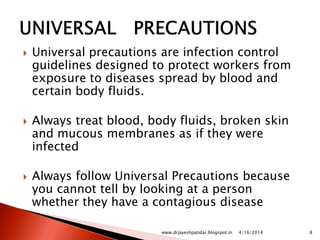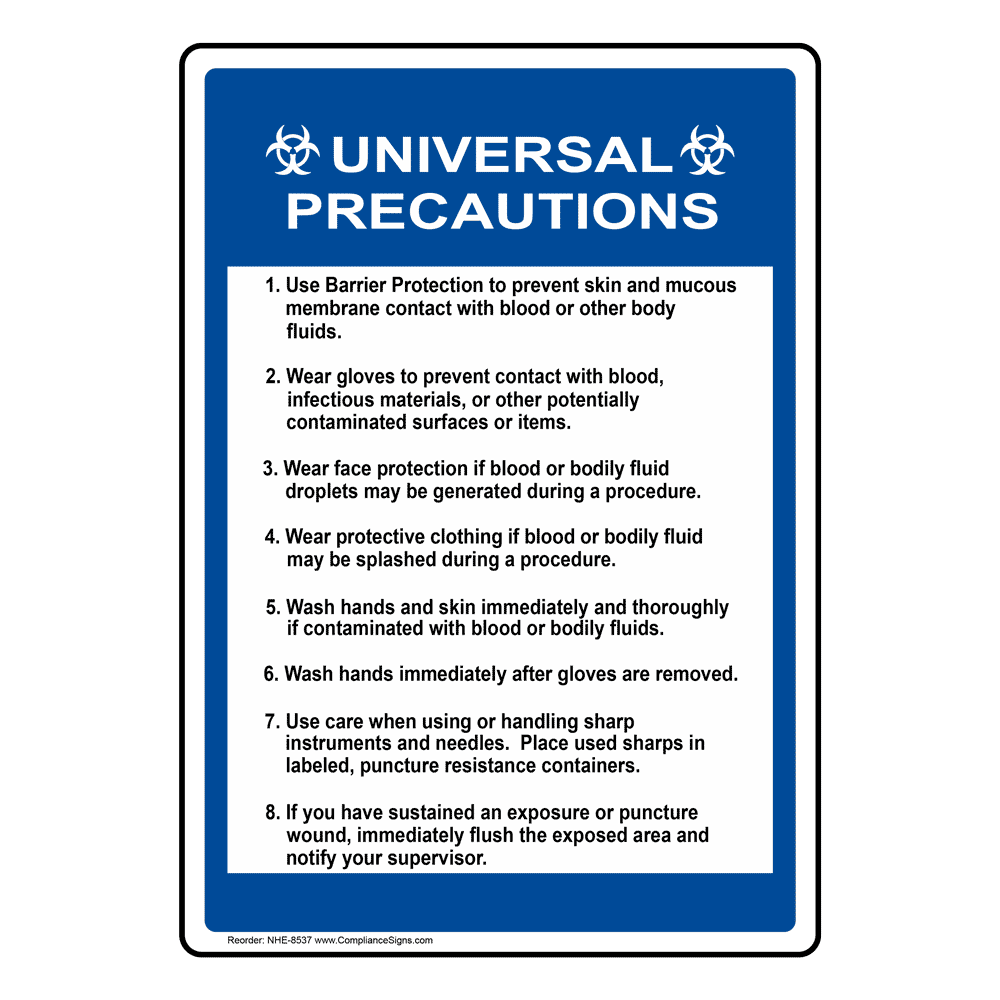universal precautions pdf
Wear 1 a surgical or procedure mask and eye pro- tection eye visor goggles or 2 a face shield to protect mucous membranes of the eyes nose and mouth during activities that are likely to generate splashes or sprays of blood body fluids secretions and excretions. Universal Precautions To avoid getting infected with HIV Hepatitis B or C or another communicable disease use the following precautions when you come into contact with any body fluids or fecal matter.

Enhanced Standard Precautions Prevent Spread Of Covid 19 In Healthcare Aimed Let S Talk About Antibiotics
Treat human blood spills with caution.

. Universal precautions were particularly made to protect against blood and other bloody bodily fluids that could be infectious. Universal Precautions are basic procedures that protect against infectious diseases transferred by DIRECT contact through blood and body fluids. Respiratory hygiene cough etiquette.
With this approach all human blood and certain body fluids are treated as if they are infectious for. UNIVERSAL PRECAUTIONS SUMMARY Wear gloves lab coat or gown when handling human blood tissue or body fluids. All staff are required to follow universal precautions and sanitary practices including.
Health care facilities providing services in which there is a risk of skin eye mucous membrane or parenteral contact to human blood or other potentially infectious materials must practice universal precautions. Standard Precautions include Hand hygiene. Sharps safety engineering and work practice controls.
Universal precautions apply to the following infectious materials. Sterile instruments and devices. Use of proper handwashing 2.
Use of gloves in contact with infectious materials 3. First line of defense to break the chain of infection. These apply to all personnel.
Wear vinyl or rubber disposable gloves when handling blood or body fluids. Have them hold pressure until the bleeding stops. Hence they are precautions against bloodborne pathogens.
A methodo logy for trauma-informed justice. To effectively prevent the spread of communicable disease the occupational safety and health administration osha requires workers who might come into contact with blood and other body fluids to practice the following infection control practices at all times with everyone. Journal of Community S afety and Well-Being 6 3 15 615 9.
The term universal is used because it is assumed that all blood and bodily fluids from any person should be considered potentially infectious. You can also use paper towels tissue or newspaper. Universal precautions a method of infection control recommended by Centers for Disease and the Prevention CDC in which all human blood and certain body fluids of human origin are handled as if they are known to be infected with human immunodeficiency virus HIV hepatitis B virus HBV andor other bloodborne pathogens.
Universal Precautions UT Southwestern Medical School standard precautions training UT Southwestern Medical Center Created Date. HIV Human Immunodeficiency Virus HBV Hepatitis B Virus Other bacteria and viruses that can cause diseases in humans. Use of personal protective equipment eg gloves masks eyewear.
Effectiveness of Standard Precautions depends on how well steps are. The child or adult should hold an absorbent material to the wound - a clean disposable diaper offers a good absorbent material with the added protection of a plastic backing. Gloves contribute an added measure of protection but are not essential if skin is intact.
One section of the standard deals with Universal Precautions UP. This term is simply an approach or strategy designed to ensure staff safety when working with blood or other bodily fluids. Clean up blood spills promptly.
Post biohazard universal precautions signs on doors and equipment These requirements are based on the Division of Occupational Limit lab access while work is being conducted Properly dispose under Equipment Biosafety Cabinetsof biohazardousmedical waste into appropriate waste containers Wash hands after completion of work and before leaving laboratory. Refer any spills to housekeeping promptly for proper clean up using absorbent material such as paper towels then cleaning thoroughly with a disinfectant such as a solution of 10. Safe injection practices ie aseptic technique for parenteral medications.
Under Universal Precautions blood and certain other human body fluids are considered potentially infectious for HIV HBV and other bloodborne pathogens. 1hand washing 2use of latex gloves 3environmental disinfection. If exposed to blood and other body fluids.
Cover any and all open cuts or broken skin or ask another staff member to do the clean up. Do not smoke eat drink or apply cosmetics in the workplace. Under UP the blood and certain bodily fluids of all individuals are considered potentially infectious.
Do not store food or drinks in refrigerators freezers cabinets or bench tops where blood or other potentially infectious materials may be present. Wash clothes Soiled items should be stored in sealed plastic bags. Universal Precautions means the prevention of disease transmission through the use of infection control practices with all patients.
All individuals should apply universal precautions in all setting and at all times. Bodily fluids visibly contaminated by blood. Inspect the intactness of skin on all exposed body parts especially the hands.
These precautions are written in accordance with guidelines established by the Center for Disease Control CDC and OSHA. In order to be safe and not to discriminate assume that everyone is infectious. Laboratories BMBL 5th EditionWash hands after completion of work and before leaving laboratory Decontaminate equipment daily and following any spill Eating drinking applying lip balm or contact lenses only permitted in approved non-research areas No mouth pipetting Personal Protective Equipment PPE.
Universal Precautions Blood and certain body fluids are assumed to be possibly infected and precautions are taken universally in all potential exposure situations. One of the most important strategies to prevent transmission of infectious agents. Use of a gown or apron when clothing may become soiled.
Proper hand hygiene is one such precaution. Preventing Transmission with Standard Precautions Infection prevention practices used to avoid the transmission of infectious agents. Are a set of precautions designed to prevent transmission of human immunodeficiency virus HIV hepatitis B virus HBV and other bloodborne pathogens when providing first aid or health care.
Universal Precautions are the steps you need to take to ensure that both you and your participants are not exposed to any infectious blood or bodily fluid at your WIC clinic. Universal precautions are a standard set of guidelines to prevent the transmission of bloodborne pathogens from exposure to blood and other potentially infectious materials OPIM. H tt ps do io rg 10 3 5 5 0 2 j c s w b 19 4.
Associated with specimen processing should also be Gown. Universal precautions were introduced by the Centers for Disease Control CDC in 1985 mostly in response to the human immunodeficiency virus HIV epidemic.

Pdf Knowledge And Practices Of Universal Precautions Among Qualifying Nursing Students

Infection Control Pdf Universal Precaution

Free Cdc Standard Precautions And Other Infection Control Reminders Infection Control Nursing Infection Control Nursing Study

Infection Control Pdf Universal Precaution

Infection Control Pdf Universal Precaution

Cdc Standard Precautions Posters Infection Control Nursing Infection Control Basic Life Support

Free 2017 Cdc Standard Precaution Posters Downloads Now In Pdf And Printer Friendly Includes Standard Precau Airborne Precautions Contact Precautions Printer

Printable Universal Precautions Sign

Standard Precautions Ucsf Health Hospital Epidemiology And Infection Prevention

Pdf Practice Of Universal Precautions Among Healthcare Workers

Standard Precautions In Health Care

Pdf Standard Precautions In Clinical Practices A Review






Comments
Post a Comment